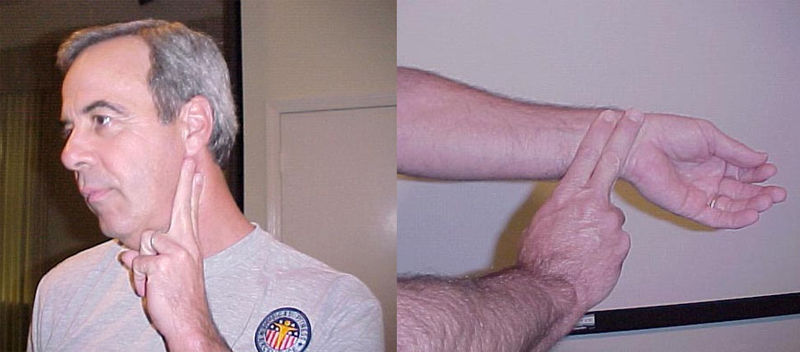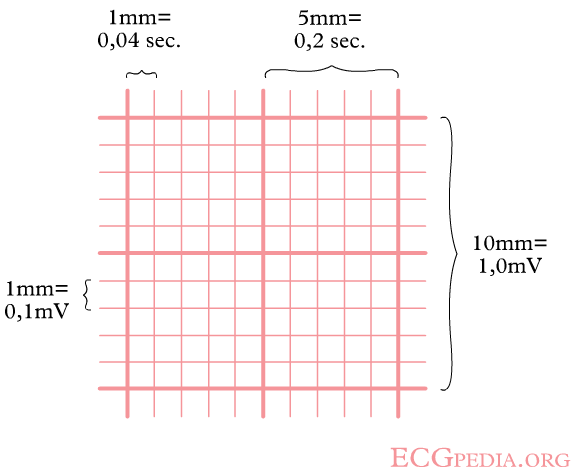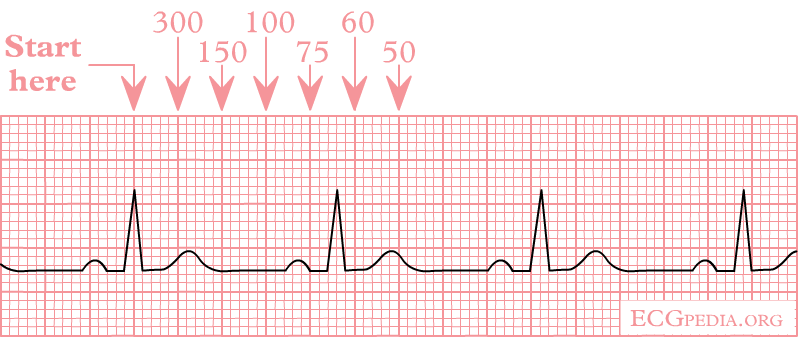Heart rate
| Heart rate | |
 | |
|---|---|
| Measuring the pulse at the neck and wrist |
|
WikiDoc Resources for Heart rate |
|
Articles |
|---|
|
Most recent articles on Heart rate |
|
Media |
|
Evidence Based Medicine |
|
Clinical Trials |
|
Ongoing Trials on Heart rate at Clinical Trials.gov Clinical Trials on Heart rate at Google
|
|
Guidelines / Policies / Govt |
|
US National Guidelines Clearinghouse on Heart rate
|
|
Books |
|
News |
|
Commentary |
|
Definitions |
|
Patient Resources / Community |
|
Patient resources on Heart rate Discussion groups on Heart rate Patient Handouts on Heart rate Directions to Hospitals Treating Heart rate Risk calculators and risk factors for Heart rate
|
|
Healthcare Provider Resources |
|
Causes & Risk Factors for Heart rate |
|
Continuing Medical Education (CME) |
|
International |
|
|
|
Business |
|
Experimental / Informatics |
Editor-In-Chief: C. Michael Gibson, M.S., M.D. [1]
Overview
Heart rate is a term used to describe the frequency of the cardiac cycle. It is considered one of the four vital signs. Usually it is calculated as the number of contractions (heart beats) of the heart in one minute and expressed as "beats per minute" (bpm). See "Heart" for information on embryofetal heart rates.
When resting, the average adult human heart beats at about 70 bpm (males) and 75 bpm (females); however, this rate varies among people and can be significantly lower in athletes. The infant/neonatal rate of heartbeat is around 130-150 bpm, the toddler's about 100–130 bpm, the older child's about 90–110 bpm, and the adolescent's about 80–100 bpm.
The pulse is the most commonly used method of measuring the heart rate. This method may be inaccurate in cases of low cardiac output, as happens in some arrhythmias, where the heart rate may be considerably higher than the pulse rate.
Listening to heart sounds using a stethescope, a process known as Auscultation, is a more accurate method of measuring the heart rate.
Measuring heart rate
The pulse rate (which in most people is identical to the heart rate) can be measured at any point on the body where an artery's pulsation is transmitted to the surface - often as it is compressed against an underlying structure like bone. Some commonly palpated sites are as listed.
- The inside of the wrist on the side of the thumb (radial artery) , (and less commonly ulnar artery on the pinky side which is deeper and harder to palpate )
- The neck (carotid artery),
- The inside of the elbow, or under the biceps muscle (brachial artery)
- The groin (femoral artery),
- Behind the medial malleolus on the feet (posterior tibial artery)
- Middle of dorsum of the foot (dorsalis pedis).
- Behind the knee (popliteal artery)
- Over the abdomen (abdominal aorta)
- The chest. (aorta)This can be felt with one's hands or fingers but it is possible to auscultate the heart by utilizing a stethoscope.
NOTE: The thumb should never be used for measuring heart rate, as its strong pulse may interfere with discriminating the site of pulsation, and you may count the thumb's pulse accidentally when measuring'[1]
Producing an electrocardiogram, or ECG (also abbreviated EKG), is one of the most precise methods of heart rate measurement. Continuous electrocardiographic monitoring of the heart is routinely done in many clinical settings, especially in critical care medicine. Commercial heart rate monitors are also available, consisting of a chest strap with electrodes. The signal is transmitted to a wrist receiver for display. Heart rate monitors allow accurate measurements to be taken continuously and can be used during exercise when manual measurement would be difficult or impossible (such as when the hands are being used).
The square counting method
The square counting method is ideal for regular heart rates. Use the sequence 300-150-100-75-60-50-43-37. Count from the first QRS complex, the first thick line is 300, the next thick line 150 etc. Stop the sequence at the next QRS complex. When the second QRS complex is between two lines, take the mean of the two numbers from the sequence.

The marker method
Non-regular rhythms are best determined with the "3 second marker method". Count the number of QRS complexes that fit into 3 seconds (some ECG writers print this period on the ECG paper). Multiply this number by 20 to find the number of beats/minute.

Maximum heart rate
Maximum heart rate (also called MHR, or HRmax) is the highest number of times your heart can contract in one minute, or the heart rate that a person could achieve during maximal physical exertion. It is not the maximum one should obtain often during exercise. MHR is used as a base number to calculate target heart rate for exercise (see below). Research indicates it is most closely linked to a person's age; a person's HRmax will decline as they age. [2] People who have participated in sports and athletic activities in early years will have a higher MHR than those less active as children.
Measuring HRmax

The most accurate way of measuring HRmax for an individual is via a cardiac stress test. In such a test, the subject exercises while being monitored by an electrocardiogram (ECG). During the test, the intensity of exercise is periodically increased (if a treadmill is being used, through increase in speed or slope of the treadmill) until the subject can no longer continue, or until certain changes in heart function are detected in the ECG (at which point the subject is directed to stop). Typical durations of such a test range from 10 to 20 minutes.
Since the HRmax declines with age, this test does not hold permanent value.
A less costly way to calculate is to warm up thoroughly on a bike (maybe 15 minutes on the flats). On a long, steady hill (doesn't have to be steep) increase effort every minute for at least 5 minutes until you can't go any faster (sitting, not standing). Then full-out sprint for 15 seconds (it is OK to stand at this point). Stop, get off the bike (this is for safety reasons - not mandatory) and immediately check your heart rate at its maximum for a full 60 seconds this is because 30 seconds and doubling it is inaccurate as you may have a heart Problem and it may change in the last sector of the reading.
Many exercise machines (stationary bikes, treadmills, etc) have a built-in heart rate monitors. To ensure you are getting an accurate MHR reading, it's best to do this test on different days. Also, if you are doing this at a health club, try using various machines.
Conducting a maximal exercise test can require expensive equipment. If you are just beginning an exercise regimen, you should only perform this test in the presence of medical staff due to risks associated with high heart rates. Instead, people typically use a formula to estimate their individual Maximum Heart Rate. The most common formula encountered is:
- HRmax = 220 − age (caution: can vary significantly!)
This is attributed to various sources, often "Fox and Haskell". While the most common (and easy to remember and calculate), this particular formula is not considered by some to be a good predictor of HRmax.
A 2003 study [2] of 43 different formulae for HRmax (including the one above) concluded the following:
1) No "acceptable" formula currently existed, (they used the term "acceptable" to mean acceptable for both prediction of <math>V_{\mathrm{O}_2 max}</math>, and prescription of exercise training HR ranges)
2) The most accurate formula of those examined was:
- HRmax = 205.8 − (0.685 * age)
This was found to have a Standard Deviation that, although large (6.4 bpm), was still deemed to be acceptable for the use of prescribing exercise training HR ranges.
Other often cited formulae are:
- HRmax = 206.3 − (0.711 * age)
(Often attributed to "Londeree and Moeschberger from the University of Missouri–Columbia")
- HRmax = 217 − (0.85 * age)
(Often attributed to "Miller et al. from Indiana University")
These figures are still dependent on physiology and fitness - for example an endurance runner's rates will typically be lower due to the increased size of the heart required to support the exercise, while a sprinter's rates will be higher due to the improved response time and short duration. Also, averages are just that. You can have two 40 year old males with same height, weight, strength, etc. 220-40=180. But these two males could have a MHR 20 beats apart (e.g. 170-190). It's important to not guess.
Recovery heart rate
This is the heart rate that our body will decrease to after an exercise session. For example, you exercise for a 1/2 hour at 160 BPM. Two minutes after you stop exercising, your heart rate decreases to 95. The 95 would be your recovery heart rate. This is used to evaluate your fitness level after exercise. It is good to set a two minute time frame and see how many beats you recover in that time frame. Compare this recover heart rate between exercise sessions. Measured over a 15-second sampling interval. NOTE: The thumb should never be used for measuring someone else's heart rate, as it has a pulse of its own.[2] A drop of 20 beats in a minute is typical for a healthy person. A drop of less than 12 beats per minute after maximal exercise has been correlated with a significant increase in mortality [3].
Target heart rate
Target heart rate (THR), or training heart rate, is a desired range of heart rate reached during aerobic exercise which enables one's heart and lungs to receive the most benefit from a workout. This theoretical range varies based on one's physical condition, age, and previous training. Below are two ways to calculate one's Target Heart Rate. In each of these methods, there is an element called "intensity" which is expressed as a percentage. THR can be calculated by using a range of 50%–85% intensity. However, it is crucial one have an accurate MHR calculation first to ensure these calculations are meaningful (see above).
Effecting Heart Rate
Having an increase in heart rate can be for a range of reasons; arousal, stress and anxiety; highly aroused individuals are mentally and physically activated; they experience increased heart rate, respiration and sweating.
Karvonen method
The Karvonen method factors in Resting Heart Rate (HRrest) to calculate Target Heart Rate (THR):
- THR = ((HRmax – HRrest) × %Intensity) + HRrest
Example for someone with a HRmax of 180 and a HRrest of 70:
50% intensity: ((180 − 70) × 0.50) + 70 = 125 bpm
85% intensity: ((180 − 70) × 0.85) + 70 = 163 bpm
Zoladz method
An alternative to the Karvonen method is the Zoladz method, which derives exercise zones by subtracting values from HRmax.
- THR = HRmax – Adjuster ± 5 bpm
- Zone 1 Adjuster = 50 bpm
- Zone 2 Adjuster = 40 bpm
- Zone 3 Adjuster = 30 bpm
- Zone 4 Adjuster = 20 bpm
- Zone 5 Adjuster = 10 bpm mpg32
Example for someone with a HRmax of 180:
Zone 1 (easy exercise) : 180 - 50 = 130; ± 5 → 125 to 135 bpm
Zone 4 (tough exercise): 180 - 20 = 160; ± 5 → 155 to 165 bpm
Heart rate reserve
Heart rate reserve (HRR) is a term used to describe the difference between a person's measured or predicted maximum heart rate and resting heart rate. Some methods of measurement of exercise intensity measure percentage of heart rate reserve. Additionally, as a person increases their cardiovascular fitness, their HRrest will drop, thus the heart rate reserve will increase. Percentage of HRR is equivalent to percentage of VO2 reserve.
- HRR = HRmax − HRrest
Heart rate abnormalities
Tachycardia
Tachycardia is a resting heart rate more than 100 beats per minute. This number can vary as smaller people and children have faster heart rates than adults.
Bradycardia
Bradycardia is defined as a heart rate less than 60 beats per minute although it is seldom symptomatic until below 50 bpm. Trained athletes tend to have slow resting heart rates, and resting bradycardia in athletes should not be considered abnormal if the individual has no symptoms associated with it. Again, this number can vary as smaller people and children have faster heart rates than adults.
Miguel Indurain, a cyclist and five times Tour de France winner, had a resting heart rate of 28 beats per minute, one of the lowest ever recorded in a healthy human.[3]
Related Chapters
Sources
- Copyleft images obtained courtesy of ECGpedia, http://en.ecgpedia.org/index.php?title=Special:NewFiles&dir=prev&offset=20080806182927&limit=500
References
- ↑ Regulation of Human Heart Rate. Serendip. Retrieved on June 27, 2007.
- ↑ Physical Activity for Everyone. Department of Health and Human Services, Centers for Disease Control and Prevention. Retrieved on May 1, 2007.
- ↑ Cardiac Output. Retrieved on May 1, 2007.